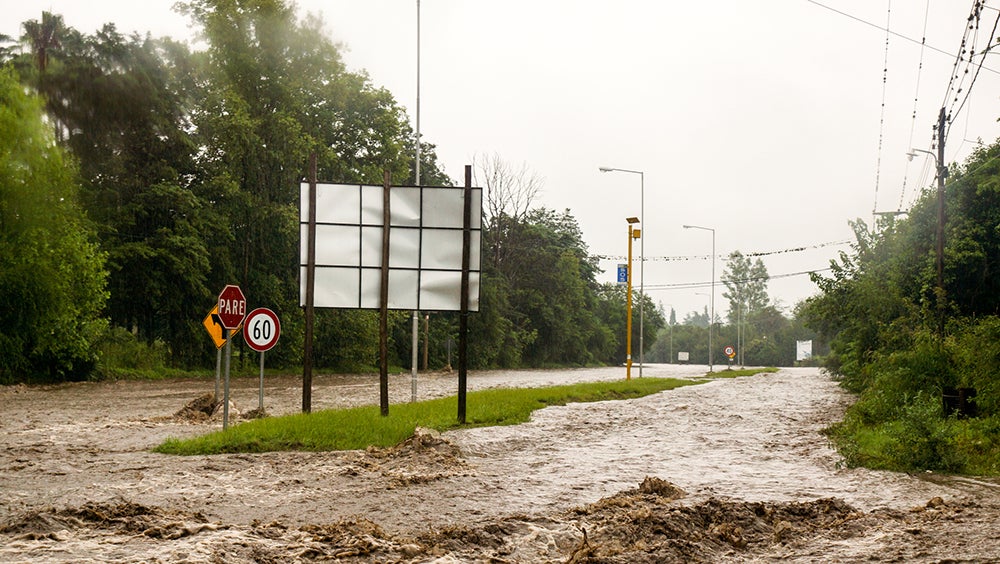
As the ongoing COP26 conversations in Glasgow reveal, extreme weather events are becoming more frequent because of climate change, disrupting our lives, and inducing economic losses beyond the costs of repair. Only in July 2021, heavy rains produced catastrophic flooding leading to more than US$ 11 billion in property damages both across central Europe and in the Chinese province of Henan.
In Latin America, floods in northern Argentina (provinces of Chaco, Corrientes, Formosa, and Jujuy) have caused major disruptions in recent years, leading to significant economic losses, population displacements and, in some cases, even loss of life.
Climate change is already a reality and its consequences palpable. Therefore, we cannot limit our actions to stopping the rise in temperatures, we must learn to adapt to the new climate reality. Transport infrastructure is a key element for the world’s economic development and growth, and it is particularly exposed to these ever more frequent extreme weather events. To mitigate climate risks, construction and maintenance of the transport network should be adapted to increase its resilience, and construction codes across the world are beginning to adopt these changes.
What happens in Argentina?
In Argentina, temperatures will increase by between 0.5 and 1°C, under Representation Concentration Pathway (RCP) 4.5 and 8.5, inducing an increase in precipitation volume and number of days with extreme precipitation. This will make the country more vulnerable to flooding, which is already responsible for US$ 22.5 billion in economic losses since 1980, not to speak of the loss of life produced by events like the floods in La Plata in 2013.
Argentina’s vast network of national, provincial, and rural roads, spanning more than 240,000 kilometers, is critical for the country’s growth and development. Climate change-related threats are projected to impact an estimated 4.5% to 7% of its GDP, and failures in the transport infrastructure may exacerbate these negative effects.
In this context, the World Bank and the Global Facility for Disaster Reduction and Recovery (GFDRR) published this report that studies and estimates direct and indirect macroeconomic losses resulting from transport disruptions, particularly flood-related risks.
The report uses a system-of-systems methodology, defining the transport network as a collection of nodes (ports, airports, stations, road junctions) and links (road sections, railway lines, waterways), assessing for each of them:
- Vulnerability, which is a measure of the negative consequences of infrastructure failure caused by extreme shock events. It is estimated based on flood depth levels, assuming complete loss of network functionality above a certain depth threshold.
- Criticality, which is a measure of infrastructure importance and disruptive impact on the rest of the network. It is assessed based on the impact that an asset’s failure would have, calculating not only the cost of the damage done to the infrastructure, but also the indirect cost of rerouting transport flows.
Vulnerability and criticality assessments result in a risk evaluation considering the likelihood of the hazard and the consequences of the transport element’s failure. These consequences include direct infrastructure damage, measured by the Expected Annual Damage (EAD) indicator, as well as indirect economic losses incurred by the interruption of service, measured using the using the Expected Annual Economic Loss (EAEL). The report’s analysis is completed with an evaluation of actions to climate-proof infrastructure elements, which undergo a cost-benefit analysis. Costs include initial and routine maintenance investments, while benefits consist of the avoided losses in terms of direct damage (EAD) and indirect economic risks (EAEL).
The results from the report show an increase in the vulnerability of transport infrastructure because of climate change. National roads are expected to be 10% or 20% more exposed to pluvial floods under medium and high climate-change projections, compared to their current exposure. Key airports and ports’ vulnerability is assessed as the minimum return period at which it the infrastructure is subject to extreme flooding.
Areas most affected and recommendations
In terms of criticality, the highest disruptions occur on national roads radiating from Buenos Aires, which when affected by flooding can cause disruptions of around 100,000 tons per day. If flood hazards were to cause individual road and railway links to fail, the resulting economic impacts could reach US$3.0 million per day for provincial roads 14 and 49, connecting Buenos Aires and La Plata; US$4.2 million per day for Roca rail line in Buenos Aires; and US$700,000 per day for national road bridges in the provinces of Mendoza or San Luis.
The report provides a baseline to compare interventions and prioritise those with the highest benefit to cost ratio (BCR). Infrastructure elements where the avoided direct and indirect losses of failure are highest, in comparison to the cost of upgrading interventions, should be prioritised. Roads with the highest BCR values are concentrated in Northwestern Argentina.
In summary, this study is an attempt to aggregate all the transport infrastructure and logistics data of Argentina in one platform, providing a model for the use of the National Road Directorate (Dirección Nacional de Vialidad, DNV) and the Ministry of Transport. Economic impacts of extreme weather events disruptions can become significant, depending on the rerouting options and the duration of the disruption. By quantifying the direct damage and accounting for the macroeconomic losses from these disruptions, those institutions can improve design, construction, and maintenance of Argentina’s transport infrastructure.
In a climate change scenario, building resilient infrastructure might result in marginal additional costs, but for many infrastructure assets, the benefits of avoiding flood damages and disruptions outweigh the investment costs.

Areas most affected and recommendations
In terms of criticality, the highest disruptions occur on national roads radiating from Buenos Aires, which when affected by flooding can cause disruptions of around 100,000 tons per day. If flood hazards were to cause individual road and railway links to fail, the resulting economic impacts could reach US$3.0 million per day for provincial roads 14 and 49, connecting Buenos Aires and La Plata; US$4.2 million per day for Roca rail line in Buenos Aires; and US$700,000 per day for national road bridges in the provinces of Mendoza or San Luis.
The report provides a baseline to compare interventions and prioritise those with the highest benefit to cost ratio (BCR). Infrastructure elements where the avoided direct and indirect losses of failure are highest, in comparison to the cost of upgrading interventions, should be prioritised. Roads with the highest BCR values are concentrated in Northwestern Argentina.
In summary, this study is an attempt to aggregate all the transport infrastructure and logistics data of Argentina in one platform, providing a model for the use of the National Road Directorate (Dirección Nacional de Vialidad, DNV) and the Ministry of Transport. Economic impacts of extreme weather events disruptions can become significant, depending on the rerouting options and the duration of the disruption. By quantifying the direct damage and accounting for the macroeconomic losses from these disruptions, those institutions can improve design, construction, and maintenance of Argentina’s transport infrastructure.
In a climate change scenario, building resilient infrastructure might result in marginal additional costs, but for many infrastructure assets, the benefits of avoiding flood damages and disruptions outweigh the investment costs.




Join the Conversation